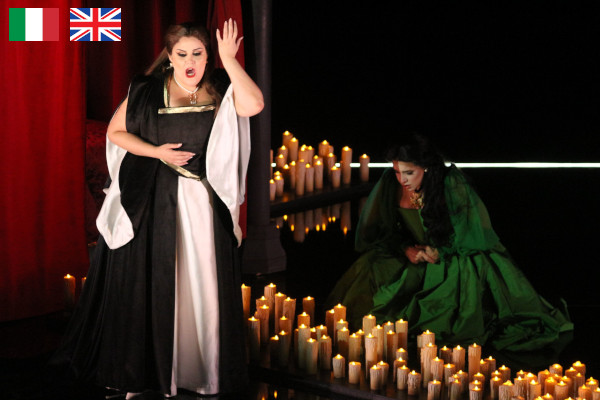Anna Bolena at the Teatro Amazonas
by Fabiana Crepaldi
Manaus, 20th May 2023 - Celebrating Maria Callas' centenary, the 25th Amazonas Opera Festival presented Anna Bolena, Gaetano Donizetti's first success, absent from Brazilian stages since the 1840s. For this revival, the almost four-hour opera was presented with no cuts, featuring a Brazilian cast and a modern production that preserved the classic character of the work. During the festival, which also hosted the Ópera Latinoamérica (OLA) conference, the same orchestra and choir performed in four operas on consecutive days. All this took place in the special city of Manaus, in the heart of the Amazon rainforest. A true miracle of the divine Maria Callas.
The chosen title couldn't have been better. In 1957, at La Scala, in a Luchino Visconti production, Maria Callas was responsible for the return of this opera to the repertoire. In fact, her Anna Bolena consolidated the rescue of the bel canto style, which had been distorted by the verista interpreters.
Another link between Maria Callas and Anna Bolena is that Callas was a kind of tragic heroine both on stage and in life, like the heroine of Romani and Donizetti. On stage, the recordings are witness to her dramatic interpretations. In life, her great personal tragedy was her relationship with Aristotle Onassis, who abandoned her to marry Jacqueline Kennedy.
With brilliance and using a psychological approach, stage director André Heller-Lopes managed to interweave on stage Maria Callas and Anna Bolena. He made the idea clear from the very beginning. During the overture photos of Callas, Onassis and Jackie Kennedy were projected, as well as a few images of the 1957 production and Callas wearing a black dress with red flowers, in which the opera's protagonist would appear in a few minutes.
Throughout the opera, Heller-Lopes brought together images of La Scala, elements of Visconti's legendary production, well-known costumes worn by Callas and Jackie Kennedy, and a delimitation on the stage, separating reality from the stage play.
Melissa Maia's costumes were efficient and very well made. While the male characters wear period clothes, Anna entered wearing Callas' dress shown in the opening projections. It is a everyday dress, not a costume, so it was an image of Callas reliving that historical moment.
Wearing in the first act a red dress and, in the second, a green one, Giovanna Seymour stands out from the other characters, pointing to her royal future (as soon as she enters, she contemplates the empty throne). At the end, she will appear in Jackie Kennedy's tailleur – Giovanna and Jackie will become the same person.
Renato Theobaldo's intelligent and well-finished scenery delimits the environment of the stage play, in a rectangle of LED lights. In the background first appears the image of the La Scala's boxes hanging on a curtain. It was a distorted image from a distorted memory, emphasized by the Fabio Retti's excellent lighting.
During the duet between Anna and Giovanna in the second act, candles form a cross. In the centre, Anna's bed inside red curtains. The sacrifice that was being prepared, in which Anna herself would be the offering? Anna is wearing Giuditta Pasta's dress at the premiere of the opera, in 1830.
William Ashbrook, author of Donizetti and his Operas, points out the power of the final scene: “combining aspects of the mad scene and the death scene, it vividly presents the stages of Anna's retreat from unendurable reality, through longing for release, to triumph, once her reason is restored, as she finds the spiritual strength not to curse but to forgive those who have brought her to her death.” Maria Callas too found the strength to forgive Onassis.
This scene was the most beautiful and inspired moment of the production. The scenery of the same scene in the mythical Visconti production appears on transparent screens, in layers, forming an image that at the same time creates an effect of depth and lack of focus, a hazy image, in which various memories blend together. It is a phantasmagoric scene made of shadows, like Anna's delirium, that mixes her past with the present all in a distorted way. It also matches the turmoil that befell Callas, who lived with the memory of a glorious past, while her love life crumbled. The beautiful female chorus enters with all the singers wearing dark veils, making the scene even stronger and reinforcing the phantasmagorical character. The tragedies of Anna and Callas were already foreseen.
Anna arrives in this scene wearing the dress that Callas wore in the La Scala production. In her beautiful cantabile Al dolce guidami, she dialogues with an obbligato English horn, which was played from the stage, highlighting the melancholic and sad line of the solo.
The cast featured a good team of comprimarios singers. Both tenor Wilken Silveira and bass Murilo Neves performed efficiently as Hervey and Rochefort. Mezzosoprano Juliana Taino and the Argentine tenor Francisco Brito shone as Smeton and Percy: from them came the best moments of bel canto. Brito enchanted the audience with the brilliance of his timbre and his beautiful phrasing. Taino was in great form both vocally and scenically: Smeton's cavatina Un bacio ancora was one of the best musical numbers of the evening.
In the leading trio, the Enrico VIII of Sávio Sperandio stood out. With a powerful voice, precise tuning and expressive phrasing, he embodies a cold, sarcastic Enrico, who borders on rudeness and even takes a certain pleasure in the evil he was preparing for Anna.
Unfortunately, the very young soprano Tatiana Carlos, who sang the title role, had pitch issues mainly in the high notes and had a lack of homogeneity between registers. She has a promising voice but still needs technical improvement.
In the cast of a Brazilian production paying tribute to Maria Callas, it is difficult to imagine a better choice than mezzosoprano Luisa Francesconi. She aways works closely on character construction, text and phrasing, and as Seymour she exhibited a well-projected voice. However, she was suffering from a strong flu, and it seemed that her voice is becoming a bit heavy for the role, with some difficulty in sustaining the high notes.
At the head of the Amazonas Philharmonic, Marcelo de Jesus demonstrated an intimate knowledge of the bel canto repertoire, although he could have given more support to the singers who were facing difficult roles. His work with the woodwinds was admirable. The Amazonas Choir was one of the highlights of the evening, especially the female chorus in the final scene.
De Jesus' choice to do the opera with no cuts deserves praise, but it seems to have been too much for the cast he had on hand and, consequently, for the public.



